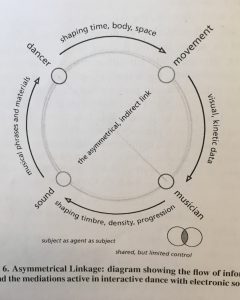Source
Jan C. Schacher. 2016. Moving Music: Exploring Movement-to-Sound Relationships. In Proceeding MOCO ’16 Proceedings of the 3rd International Symposium on Movement and Computing Article No. 19. Thessaloniki, GA, Greece
Summary
“Moving Music” is focusing on learning how ‘Gesture’ can be used when working with sound, and real time generated music, and also how ‘Gesture’ influences the perception, affect and impact of music.
So it is important to learn inter-relationship and dependency between a musician and a dancer, between movement and sound through the use of electronic sound processes that are linked by technically sensing movements.
** dancer – movement – musician – sound = audience perceptions
In order to proceed this project, the dancer is equipped with two bracelet (wireless motion sensors) that capture degrees of Acceleration Rotation Attitude. Each sensor is attached to the each ankle (left, right) and one on the stomach and dancers perform and each gesture of the dancer shapes its own music.
To obtain position information of the dancer in space, the stage is observed by a depth-camera located in front center of the stage at floor level. The use of stage is implemented using a map zones overlaid on the stage. Each zone has a radial sensitivity curve that rises from its edge to the center.

Video: http://mgm.zhdk.ch/?page_id=1406
Relevance
I haven’t mentioned everything here, but this article deals with deeper psychological and technical ways to understand how performance on the stage to unite the movements (dancers), music (musicians) and audience.
Since our project is about stage performance and interaction this article might be helpful to see how this project dealt with the depth-camera for the performance on the stage.
